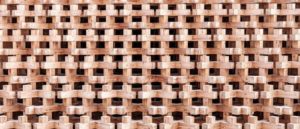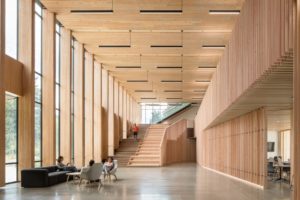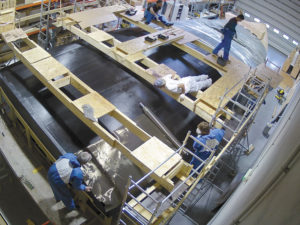As every sector looks to incorporate sustainable best-practices, so too, does the boat building industry. Professor Fahmi Bellalouna at the Karlsruhe University of Applied Sciences sums it up in an article (Innovation Origins), “The interest of customers in environmentally friendly and sustainable products has also reached the boat market. Sailing is per se an environmentally friendly and sustainable form of mobility that only uses wind and thermal as energy sources. As a result, many customers now pay attention to the composition of materials and the manufacturing processes of sailboats.”

New technologies in timber make it stronger, more sustainable, and lower in CO2 emissions than traditional building materials. 44-ft Italmus, designed by Stephens Waring, features a wooden mast and boom. Photo Credit: Alison Langley
As custom yacht designers, we see the complexity of this issue first hand. We know all too well the compromises inherent in the craft. Add the noble goal of lowering the environmental impact throughout the process, and more compromises arise. As with most things, it’s important to take a comprehensive look at any improvement towards sustainability to ensure that performance and function goals can still be reached and no unintended environmental hazard is created inadvertently at a different stage.
Material selection informs the design and subsequent construction process so it is a great place to start the conversation. Metal, wood, and modified wood products are all options today. Metal, while totally recyclable, still needs to be coated with a corrosion-proof coating and is operationally inefficient for smaller and faster yachts.
Wood, the only wholly natural medium, is an excellent renewable source when certain criteria are met. According to the American Forest Foundation, “Wood products store carbon, helping to mitigate climate change while also providing a good alternative for materials that require large amounts of fossil fuels to produce.”
Unfortunately, most custom boats are built using scarce, tropical hardwoods like teak and old-growth wood from domestic forests. Both are not sustainable choices due to slow growth of the species and the cost of transportation. Alternative wood includes fast-growing species from certified sustainable forests and of course, wood sourced locally which lessens the carbon footprint.

Modified wood is incredibly popular in the timber industry today – it’s like standard timber’s older, stronger brother. The market demand for it is continuously rising, and it doesn’t look like it’s going to stop any time soon.
Another option is “mass timber” or modified wood which is wood that has been “changed thermally or chemically to enhance its properties.” This means trees that wouldn’t normally be considered optimal choices are modified to fill in for the more desirable, expensive and less sustainable hardwoods. A wood manufacturing company out of South Wales, LIGNIA is a great example of what’s being offered in modified wood today. Their LIGNIA Yacht product is,” a high-performance modified timber which is delivered with minimal visual defects. The timber’s properties are enhanced to include greater durability against rot, stability, density and hardness and what’s more, has a rich golden-brown colour that resembles teak.” LIGNIA Yacht has already been used by Spirit Yachts’ on their Spirit CR50 deck helping them to win the first ever Environment Award at the Southampton Boat Show.

Cross laminated timber (CLT) panels made from mass timber are formed by stacking and gluing together successive perpendicular layers of wood. The layered stacks are then pressed in large hydraulic or vacuum presses to form an interlocked panel. Photo of the Oregon Forest Science Complex
In an article on LIGNIA on Proboat.com they point out that “ the processed wood shares the same weight profile as teak, which means designers and builders can swap it out in a boat plan without redoing weight studies.” The downside to modified wood is availability and cost. If it is not available stateside, the transportation cost may negate the environmental benefit of the product itself. As more manufacturers embrace these methods, we can imagine that those issues will be resolved.
Lastly, FRP (Fiber-Reinforced Plastic), a composite material, is the go-to in production boats. “FRP consists of fibers, incorporated in a matrix of thermosetting (thermoplastic) resins, usually polyester, vinylester, epoxy. They’re light-weight, corrosion-resistant and strong. However, there are a host of issues when it comes to reusing, and recycling: “the problem of recycling fiberglass and composite materials in general, is considered and studied but, although a considerable effort has been made internationally to find economically sustainable solutions, at the state of the art there are several recycling techniques but none really satisfactory.

Working with eco composites, the build crew at Innovation Yachts in Les Sables d’Olonne, France, applies Filava fiber to the balsa-cored hull of the Open 60 Ant Arctic Lab. Photo credit: Innovation Yachts
As we see from our exploration of material choice, sustainability in the boat building industry is not straightforward. Fortunately, some in this sector are developing ways in which to help us all make informed decisions when it comes to designing, and building boats. The folks at MarineShift360 have a measurement tool that assesses the entire life-cycle of a product. It measures 6 different environmental markers and calculates impact. Their goal is one we’re all striving for: “Ultimately, it allows the user to bring end of life thinking into the design stage and make a strategy to reduce overall environmental impact of the product.”
If you’d like to contribute to the relevancy and eventual success of MarineShift360’s mission, consider filling out their questionnaire. Information provided by industry insiders will help them continue to refine their life cycle assessment tool (LCA) which we can all benefit from as we seek information.
We feel strongly that collaboration is key in all things these days. As we learn more about the ways in which the industry is progressing towards sustainability, we’ll continue to share it with you. And if you’re considering a custom yacht, we’d be happy to walk you through the process and explore sustainable options with you. Until then, take good care.
Further reading
Some detailed resources for people who want to get into mass timber:
A few well-done, accessible popular-media introductions to mass timber:
- Vox, by David Roberts
- The Washington Post, by Doug Struck
- National Geographic, by Saul Elbein
- Seattle Business Magazine, by Andrea Watts and Leslie Helm
- The Economist
- The Urbanist, by Conor Bronsdon and Andrew Lewis